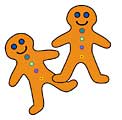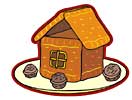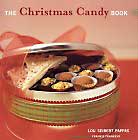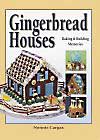|
|
 Holiday Sweets: So Many Traditions Holiday Sweets: So Many Traditions
by Marjorie Dorfman
When and why did the candy cane originate? How many different religions and cultures enjoy gingerbread and marzipan during the holidays? How do these traditions make us more the same than different? These and other tantalizing questions will be addressed below. Read on, my sweets.
|
Candy is always associated with special and happy occasions, and there are few times of the year more celebratory than Christmas. For people of all faiths and backgrounds, December marks the end of a year of evaluation, devaluation, thanks and no thanks for all that has preceded. It is the beginning of winter and festivals of lights and dazzling displays for Christians and Jews. Food is the one thing that unites all cultures and eating sweets is the pinnacle of that experience. Candy can be used as great Christmas gifts for your wife, warm wishes and for congratulations. Marzipan and gingerbread are just two of many "sweets" that are always associated with Christmas. They both have a long and interesting culinary history worth mentioning here.
 Gingerbread dates back to eleventh century Europe. It was sometimes light, sometimes dark, once in a while a cookie and every now and then a bread. It was always, however, cut into the shapes of people and animals and colorfully decorated with a mold and dusted with white sugar. In Medieval England, gingerbread meant simply "preserved ginger," and was an adaptation of Gingebras, derived from the Latin name for the spice, Zingebar. It wasn’t until the 15th century that the term came to be applied to a kind of cake made with treacle, an uncrystalized syrup drained from raw sugar during the refining process, and flavored with ginger. Gingerbread dates back to eleventh century Europe. It was sometimes light, sometimes dark, once in a while a cookie and every now and then a bread. It was always, however, cut into the shapes of people and animals and colorfully decorated with a mold and dusted with white sugar. In Medieval England, gingerbread meant simply "preserved ginger," and was an adaptation of Gingebras, derived from the Latin name for the spice, Zingebar. It wasn’t until the 15th century that the term came to be applied to a kind of cake made with treacle, an uncrystalized syrup drained from raw sugar during the refining process, and flavored with ginger.
Gingerbread, from its very inception, was always a fairground delicacy. Certain shapes were associated with different seasons: buttons and flowers were found at Easter fairs, and animals and birds were featured in autumn. At Christmas, gingerbread makes its most impressive appearance in the form of beautiful little houses. Germany, of all the other European countries, has the longest tradition of flat shaped gingerbread. Their practice of making lebkuchen houses never caught on in Britain as much as it did in North America. The settlers from Northern Europe brought it along with their customs and family recipes. By the nineteenth century, America had been baking gingerbread for decades.
The versatility of the frontier spirit rendered a practicality to American gingerbread. In New England, for example, maple syrup gingerbreads were made and in the South sorghum molasses was used. More and more regional variations developed as more and more settlers from different countries arrived. In Pennsylvania particularly, the German influence was great and many traditional gingerbreads re-appeared in this area, particularly around Christmas time. No where in the world is there a greater collection of gingerbread recipes than in America. With the vast choice of ingredients, baking aids and decorative items, the imaginative cook can create the most spectacular gingerbread houses and centerpieces ever.
 Gingerbread houses can be found in the celebration of both Christian and Jewish festivals. Many bakeries make just as many Hanukkah gingerbread and candy houses as they do traditional Christian ones. It is a delicacy that transcends all cultures and traditions and well it should; for gingerbread is the king. The queen to share its sugary crown is marzipan, whose sweet story is the next to unfold. Gingerbread houses can be found in the celebration of both Christian and Jewish festivals. Many bakeries make just as many Hanukkah gingerbread and candy houses as they do traditional Christian ones. It is a delicacy that transcends all cultures and traditions and well it should; for gingerbread is the king. The queen to share its sugary crown is marzipan, whose sweet story is the next to unfold.
Marzipan is a favored delicacy that pastry chefs have been using for centuries. The sweet pliable mixture of almond paste and sugar can be found in many countries where it is used in baking and filling for cakes, cookies, breads, tortes and other mouth-watering concoctions. It is often tinted with food coloring and molded into a variety of shapes such as fruits, animals, flowers and holiday shapes. During the Christmas season, it is a favored decoration as well as a filling in numerous delicacies. (This reinforces the old adage that if you can’t hang it on the tree, you might as well eat it. This by the way, is better than beating or joining them, whether or not one finds oneself in Rome.)
There is more than one story about the origins of marzipan, but the most popular places its beginnings in Italy. According to Werner, a master baker from Germany, marzipan was created several hundred years ago during a great drought when almonds were the only substantial crop to survive. Consequently (as when life gives you lemons and lemonade is born), people learned new ways to utilize almonds. They made almond bread, almond pie, almond soup and almond pastries. (They stopped before pasta. That would have been simply too much)
Somewhere someone during these times created marzipan. People liked it so much that it flourished throughout Italy even after the famine passed. Travelers carried the recipe throughout various cities and eventually to other countries until it reached Lubeck and Hamburg, Germany. The marzipan made there is still the finest that can be found anywhere today. Look for "Made in Lubeck" or "Lubecker Marzipan" for the finest marzipan that money can buy.
The candy cane has its own unique and surprising history. (I always thought FW Woolworth created it as a tree decoration). Actually, its origins date back to more than 350 years, when candy-makers were making hard sugar-sticks. It was originally white in color and straight. The first historical reference to the familiar cane shape goes back to 1670, when the choirmaster at the Cologne cathedral in Germany, bent the sugar sticks into canes to represent a shepherd’s staff. The all-white candy canes were dispensed to children to keep them quiet during long nativity services. The custom of the clergy handing out candy canes during Christmas services spread throughout Europe and later to America.
 The first historical reference to the candy cane in America dates back to 1847, when a German immigrant, August Imgard, decorated the Christmas tree in his home in Wooster, Ohio with candy canes. No one knows who exactly invented the stripes, but it is known that Christmas cards prior to 1900 depicted only all-white candy canes. Around the same time, candy-makers added peppermint and wintergreen flavors to their candy canes and those flavors soon became traditional favorites. Gregory Keller, a Catholic priest, invented a machine to automate candy cane production in the 1950s. The first historical reference to the candy cane in America dates back to 1847, when a German immigrant, August Imgard, decorated the Christmas tree in his home in Wooster, Ohio with candy canes. No one knows who exactly invented the stripes, but it is known that Christmas cards prior to 1900 depicted only all-white candy canes. Around the same time, candy-makers added peppermint and wintergreen flavors to their candy canes and those flavors soon became traditional favorites. Gregory Keller, a Catholic priest, invented a machine to automate candy cane production in the 1950s.
 There are other more religious legends surrounding the candy cane. Some say it is the secret symbol of Christianity used during times of more oppressive circumstances. The J shape is said to represent the name of Jesus and the red stripes Christ’s blood and purity. The three red stripes symbolized the Holy Trinity and the peppermint flavor a reference hyssop; an herb referred to in the Old Testament. There is no historical evidence to support these claims and so like Tinkerbelle, they must live in the eyes of the believer. There are other more religious legends surrounding the candy cane. Some say it is the secret symbol of Christianity used during times of more oppressive circumstances. The J shape is said to represent the name of Jesus and the red stripes Christ’s blood and purity. The three red stripes symbolized the Holy Trinity and the peppermint flavor a reference hyssop; an herb referred to in the Old Testament. There is no historical evidence to support these claims and so like Tinkerbelle, they must live in the eyes of the believer.
Chocolates, almond cookies, macaroons of all kinds and sugarplums all dance around our high calorie heads. But they dance joyfully, for we all only live once and what would life be without chocolate? So indulge and enjoy. but remember this important holiday rule of the road. Your dentist is having a fine holiday too and your over-indulgence may well help him make his own ends meet in the coming year!
Happy Sweets And Holidays To All!

Did you know . . . ?
|
|
|
|
 |
|
|
Don't miss these excellent books:
The Christmas Candy Book
by Lou Seibert Pappas, Frankie Frankey

A beautiful book with easy recipes for things not seen very often, such as sugar plums. Contains some nice pictures. A must for the Christmas baker!
Gingerbread Houses: Baking and Building Memories
by Nonnie Cargas

This Gingerbread book is the best I've seen. If you are a beginner you will have no problems succeeding with your first gingerbread houses. If you are a master, you will find that the detail and suggestions for expanding your craft are all in one book. It doesn't feel like Christmas until we've built our houses. You need a book like this which is long on ideas...have fun!
|

Click for a printer friendly version of this article.
|
|